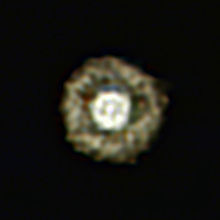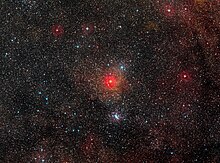Yellow hypergiant: Difference between revisions
Added Category:Articles containing video clips & general fixes using AWB (10741) |
Lithopsian (talk | contribs) refs |
||
| Line 29: | Line 29: | ||
* [[V509 Cassiopeiae]] |
* [[V509 Cassiopeiae]] |
||
* [[IRC+10420]] (V1302 Aql) |
* [[IRC+10420]] (V1302 Aql) |
||
* [[IRAS 18357-0604]] |
* [[IRAS 18357-0604]]<ref name=clark2014>{{cite doi|10.1051/0004-6361/201322772}}</ref> |
||
* [[V766 Centauri]] (= HR 5171A) |
* [[V766 Centauri]] (= HR 5171A) |
||
* [[HD 179821]] |
|||
* [[HD 179821]] <ref name="Note">According to some scientists HD 179821 may be actually a [[protoplanetary nebula]]/post-[[asymptotic giant branch|AGB]] star</ref> |
|||
* [[IRAS 17163-3907]] |
* [[IRAS 17163-3907]] |
||
* [[V382 Carinae]] |
* [[V382 Carinae]] |
||
In [[Westerlund 1]]: |
In [[Westerlund 1]]:<ref name=clark>{{cite doi|10.1051/0004-6361:20042413}}</ref> |
||
* W4 |
* W4 |
||
* W8a |
* W8a |
||
| Line 44: | Line 44: | ||
In other galaxies: |
In other galaxies: |
||
* [[HD 7583]] (R45 in SMC) |
* [[HD 7583]] (R45 in SMC)<ref name=dejaeger>{{cite doi|10.1007/s001590050009}}</ref> |
||
* [[HD 33579]] (in LMC) |
* [[HD 33579]] (in LMC) |
||
* [[HD 269723]] (in LMC) |
* [[HD 269723]] (R117 in LMC)<ref name=dejaeger>{{cite doi|10.1007/s001590050009}}</ref> |
||
* [[HD 269953]] (in LMC) |
* [[HD 269953]] (R150 in LMC)<ref name=dejaeger>{{cite doi|10.1007/s001590050009}}</ref> |
||
* [[HD 268757]] (R59 in LMC) |
* [[HD 268757]] (R59 in LMC)<ref name=dejaeger>{{cite doi|10.1007/s001590050009}}</ref> |
||
* Variable A (in [[Triangulum Galaxy|M33]]) |
* Variable A (in [[Triangulum Galaxy|M33]])<ref name=humphreys>{{cite doi|10.1088/0004-637X/790/1/48}}</ref> |
||
* B324 (in M33) |
* B324 (in M33)<ref name=humphreys/> |
||
== See also == |
== See also == |
||
Revision as of 16:01, 23 January 2015

A yellow hypergiant is a massive star with an extended atmosphere, a spectral class from late A to early K, an initial mass of as much as 20–50 solar masses, but having lost as much as half that mass.[1] They are amongst the most visually luminous stars, with absolute magnitude (MV) around −9, but also one of the rarest with just a handful known in our galaxy. They are sometimes referred to as cool hypergiants in comparison to O and B stars, and sometimes as warm hypergiants in comparison to red supergiants.[2][3]
Characteristics
Yellow hypergiants occupy a region of the Hertzsprung-Russell diagram above the instability strip, a region where relatively few stars are found and where those stars are generally unstable. The area is bounded on the high temperature side by the "Yellow Evolutionary Void" where stars of this luminosity become extremely unstable and experience severe mass loss.
The majority of yellow hypergiants are postulated to be post-red supergiants evolving blueward,[4] while more stable and less luminous yellow supergiants are likely to be evolving to red supergiants for the first time. There exists strong chemical and surface gravity evidence that the brightest of the yellow supergiants, HD 33579, is a high mass star currently expanding from a blue supergiant to a red supergiant.[5] Yellow hypergiants are dynamically unstable and show variation of their spectral type and temperature, at approximately constant luminosity, between an upper limit around 8,000K (the lower limit for LBV eruptions) and a lower limit around 4,000K. Examples such as Rho Cassiopeiae show slow irregular variations of small visual amplitude,[6] but are observed to show occasional larger eruptions resulting in significant increase or decrease in brightness.[7]
These stars are doubly rare because they are very massive, initially hot class O main sequence stars more than 15 times as massive as the Sun, but also because they spend only a few thousand years in the unstable yellow void phase of their lives. In fact, it is difficult to explain even the small number of observed yellow hypergiants, relative to red supergiants of comparable luminosity, from simple models of stellar evolution. The most luminous red supergiants may execute multiple "blue loops", shedding much of their atmosphere, but without actually ever reaching the blue supergiant stage, each one taking only a few decades at most. Conversely, some apparent yellow hypergiants may be hotter stars, such as the "missing" LBVs, masked within a cool pseudo-photosphere.[4] Most of them are thought to explode as supernovae without ever becoming blue supergiants again, but some may eventually pass right through the yellow void and become low mass low luminosity Luminous Blue Variables, and possibly Wolf-Rayet stars after that.[8]
Structure
According to the current physical models of stars, a yellow hypergiant should possess a convective core surrounded by a radiative zone, as opposed to a sun-sized star, which consists of a radiative core surrounded by a convective zone.[9] Because of their extreme luminosity and internal structure,[10] yellow hypergiants suffer high rates of mass loss[11] and are generally surrounded by envelopes of expelled material. A photogenic example of the nebulae that can result is IRAS 17163-3907, known as the Fried Egg, which has expelled several solar masses of material in just a few hundred years.[12]
The yellow hypergiant is an expected phase of evolution as the most luminous red supergiants evolve bluewards, but they may also represent a different sort of star. LBVs during eruption have such dense winds that they form a pseudo-photosphere which appears as a larger cooler star despite the underlying blue supergiant being largely unchanged. These are observed to have a very narrow range of temperatures around 8,000K. At the bistability jump which occurs around 21,000K blue supergiant winds become several times denser and could be result in an even cooler pseudo-photosphere. No LBVs are observed just below the luminosity where the bistability jump crosses the S Doradus instability strip (not to be confused with the Cepheid instability strip), but it is theorised that they do exist and appear as yellow hypergiants because of their pseudo-photospheres.[13]
Recent discoveries of blue supergiant supernova progenitors have also raised the question of whether stars could explode directly from the yellow hypergiant stage.[14] A handful of possible yellow supergiant supernova progenitors have been discovered, but they all appear to be of relatively low mass and luminosity, not hypergiants.[15][16]
Known yellow hypergiants


- Rho Cassiopeiae
- V509 Cassiopeiae
- IRC+10420 (V1302 Aql)
- IRAS 18357-0604[17]
- V766 Centauri (= HR 5171A)
- HD 179821
- IRAS 17163-3907
- V382 Carinae
In Westerlund 1:[18]
- W4
- W8a
- W12a
- W16a
- W32
- W265
In other galaxies:
- HD 7583 (R45 in SMC)[19]
- HD 33579 (in LMC)
- HD 269723 (R117 in LMC)[19]
- HD 269953 (R150 in LMC)[19]
- HD 268757 (R59 in LMC)[19]
- Variable A (in M33)[20]
- B324 (in M33)[20]
See also
References
- ^ Gesicki, K. (1992). "A Modelling of Circumstellar BAII Lines for the Hypergiant Rho-Cassiopeiae". Astronomy and Astrophysics. 254: 280. Bibcode:1992A&A...254..280G.
- ^ Lobel, A.; De Jager, K.; Nieuwenhuijzen, H. (2013). "Long-term Spectroscopic Monitoring of Cool Hypergiants HR 8752, IRC+10420, and 6 Cas near the Yellow Evolutionary Void". 370 Years of Astronomy in Utrecht. Proceedings of a conference held 2–5 April. 470: 167. Bibcode:2013ASPC..470..167L.
- ^ Humphreys, Roberta M.; Davidson, Kris; Grammer, Skyler; Kneeland, Nathan; Martin, John C.; Weis, Kerstin; Burggraf, Birgitta (2013). "Luminous and Variable Stars in M31 and M33. I. The Warm Hypergiants and
Post-Red Supergiant Evolution". arXiv:1305.6051v1 [astro-ph.SR].
{{cite arXiv}}: line feed character in|title=at position 72 (help) - ^ a b Attention: This template ({{cite doi}}) is deprecated. To cite the publication identified by doi:10.1086/322438, please use {{cite journal}} (if it was published in a bona fide academic journal, otherwise {{cite report}} with
|doi=10.1086/322438instead. - ^ Nieuwenhuijzen, H; de Jager, C (2000). "Checking the yellow evolutionary void. Three evolutionary critical Hypergiants: HD 33579, HR 8752 & IRC +10420". Astronomy and Astrophysic. 353: 163–176.Nieuwenhuijzen, H.; De Jager, C. (2000). "Checking the yellow evolutionary void. Three evolutionary critical Hypergiants: HD 33579, HR 8752 & IRC +10420". Astronomy and Astrophysics. 353: 163. Bibcode:2000A&A...353..163N.
- ^ Lobel, A; Israelian, G; de Jager, C; Musaev, F; Parker, J. W.; Mavrogiorgou, A (1998). "The spectral variability of the cool hypergiant rho Cassiopeiae". Astronomy and Astrophysic. 330: 659–675. Bibcode:1998A&A...330..659L.Lobel, A.; Israelian, G.; De Jager, C.; Musaev, F.; Parker, J. Wm.; Mavrogiorgou, A. (1998). "The spectral variability of the cool hypergiant rho Cassiopeiae". Astronomy and Astrophysics. 330: 659. Bibcode:1998A&A...330..659L.
- ^ Lobel; Stefanik; Torres; Davis; Ilyin; Rosenbush (2003). "Spectroscopy of the Millennium Outburst and Recent Variability of the Yellow Hypergiant Rho Cassiopeiae". arXiv:0312074v1 [astro-ph].
{{cite arXiv}}: Check|arxiv=value (help) - ^ Attention: This template ({{cite doi}}) is deprecated. To cite the publication identified by doi:10.1086/424030, please use {{cite journal}} (if it was published in a bona fide academic journal, otherwise {{cite report}} with
|doi=10.1086/424030instead. - ^ Attention: This template ({{cite doi}}) is deprecated. To cite the publication identified by doi:10.1134/S1063773711060016, please use {{cite journal}} (if it was published in a bona fide academic journal, otherwise {{cite report}} with
|doi=10.1134/S1063773711060016instead. - ^ Langer, Norbert; Heger, Alexander; García-Segura, Guillermo (1998). "Massive Stars: The Pre-Supernova Evolution of Internal and Circumstellar Structure". Reviews in Modern Astronomy 11: Stars and Galaxies. Edited by Reinhard E. Schielicke. Hamburg. 11: 57. Bibcode:1998RvMA...11...57L.
- ^ Attention: This template ({{cite doi}}) is deprecated. To cite the publication identified by doi:10.1088/0004-637X/697/1/409, please use {{cite journal}} (if it was published in a bona fide academic journal, otherwise {{cite report}} with
|doi=10.1088/0004-637X/697/1/409instead. - ^ Attention: This template ({{cite doi}}) is deprecated. To cite the publication identified by doi:10.1051/0004-6361/201117521, please use {{cite journal}} (if it was published in a bona fide academic journal, otherwise {{cite report}} with
|doi=10.1051/0004-6361/201117521instead. - ^ Attention: This template ({{cite doi}}) is deprecated. To cite the publication identified by doi:10.1051/0004-6361:20077139, please use {{cite journal}} (if it was published in a bona fide academic journal, otherwise {{cite report}} with
|doi=10.1051/0004-6361:20077139instead. - ^ Attention: This template ({{cite doi}}) is deprecated. To cite the publication identified by doi:10.1051/0004-6361:20078482, please use {{cite journal}} (if it was published in a bona fide academic journal, otherwise {{cite report}} with
|doi=10.1051/0004-6361:20078482instead. - ^ Attention: This template ({{cite doi}}) is deprecated. To cite the publication identified by doi:10.1051/0004-6361/201118372, please use {{cite journal}} (if it was published in a bona fide academic journal, otherwise {{cite report}} with
|doi=10.1051/0004-6361/201118372instead. - ^ Attention: This template ({{cite doi}}) is deprecated. To cite the publication identified by doi:10.1088/2041-8205/739/2/L37, please use {{cite journal}} (if it was published in a bona fide academic journal, otherwise {{cite report}} with
|doi=10.1088/2041-8205/739/2/L37instead. - ^ Attention: This template ({{cite doi}}) is deprecated. To cite the publication identified by doi:10.1051/0004-6361/201322772, please use {{cite journal}} (if it was published in a bona fide academic journal, otherwise {{cite report}} with
|doi=10.1051/0004-6361/201322772instead. - ^ Attention: This template ({{cite doi}}) is deprecated. To cite the publication identified by doi:10.1051/0004-6361:20042413, please use {{cite journal}} (if it was published in a bona fide academic journal, otherwise {{cite report}} with
|doi=10.1051/0004-6361:20042413instead. - ^ a b c d Attention: This template ({{cite doi}}) is deprecated. To cite the publication identified by doi:10.1007/s001590050009, please use {{cite journal}} (if it was published in a bona fide academic journal, otherwise {{cite report}} with
|doi=10.1007/s001590050009instead. - ^ a b Attention: This template ({{cite doi}}) is deprecated. To cite the publication identified by doi:10.1088/0004-637X/790/1/48, please use {{cite journal}} (if it was published in a bona fide academic journal, otherwise {{cite report}} with
|doi=10.1088/0004-637X/790/1/48instead.


